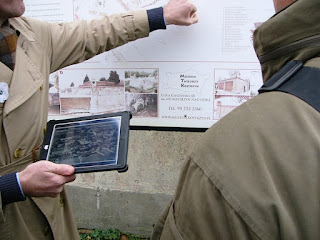 |
| The Bridge of Spies, Glienicker Brücke |
Battleground Berlin,
from 1945 to 1989, countries with opposing ideologies honed their
espionage skills in this geopolitical hub. From the turning of
individual informants, to hoovering up information en mass, the two
superpowers, and their satellites, vied to get the edge on the other
– knowledge is power. From the mundacity of sifting through shed
loads of correspondence, to daring missions behind enemy lines, no
stone was left unturned in the struggle for world dominance.
Insider guides took
some time to retrace the sites of these operations, and the
fascinating stories behind them, in and around Berlin.
 |
Kaiser Wilhelm
Memorial Church – post WWII, Berlin becomes the world's spy
capital.
|
 |
George Blake's
residence on Platanenallee.
|
 |
Charlottenburg
Palace – site of the KGB defection of Alexai Myagkov in 1974.
|
 |
ECHELON on
Teufelsberg. British Military Hospital in the foreground, location of
Hess's autopsy in 1987.
|
The Teams
British
MI (Military Intelligence) 6 / Secret Intelligence Service (SIS)
a.ka. Box 500
BRIXMIS
French
Deuxieme Bureau (until 1982) & Direction Generale de la Securite
Exterieure (DGSE)
FMLM et al.
Soviet
KGB (Commitee for State Security) and GRU (Main Intelligence
Directorate) et al.
U.S.
Strategic Services Unit (SSU) then (from 1947) Central Intelligence
Agency (CIA)
C.I.C. (until 1961), A.S.A. (until 1977), then A.S.A., INSCOM, USMLM,
FCA et al.
East Germany
Hauptverwaltung Aufklärung (HVA) and Hauptabteilung II
West Germany
Organisation Gehlen and (from 1956) Bundesnachrichtendienst
Bundesverfassungsschutz
 |
'London House',
British Military Sector HQ and counter intelligence hub.
|
 |
A spy
|
 |
Mission House,
BRIXMIS liaison location in Potsdam.
|
 |
KGB Forbidden City,
Potsdam, 3rd Directorate military counter intelligence
|
 |
First CIA HQ
location in Dahlem
|
 |
Allied Museum Dahlem
|
 |
Hastings TG503
bomber used in the Berlin airlift
|
 |
Former Kaiser
Wilhelm Society for the Advancement of Science. Site of the the first
nuclear fission by Otto Hahn, Fritz Strassmann and Lise Meitner.
|
 |
|
Site of Allied
Control Council walkout 1948.
|
 |
Him again!
|
 |
Site of the La Belle
Disco bombing 1986.
|
 |
Looking for
Operation Stopwatch Gold.
|
 |
Found it!
|
 |
Karlshorst, site of
German unconditional surrender in May 8th, 1945.
|
 |
HQ of the
KGB/GRU/SMAD, residence of Marshal Zukov.
|
 |
KGB prison '45-'63.
|
The Players
Lavrenty Beria – Petrov
Robert Bialek – Bruno Wallman
George Blake – Diamond
Anthony Blunt – Tony/Johnson
Alexei Myaglkov – n/a
Guy Burgess – Mädchen/Hicks
John Cairncross – Liszt Jeffrey
Carnney/Jens Karney –
Kid/Uwe
Nigel Dunkley – Hotspur
Allen Dulles – Mr. Bull
Musbath Eter – n/a
James Hall III – Paul
William 'Wild Bill' King Harvey – n/a
Gennadi Titov – n/a
Donald Maclean – Homer
Adjutant Chef Philippe Mariotti – n/a
Erich Mielke – Fritz
Leissner (1936-39)
Major Arthur (Nick) Nicholson – n/a
Harold (Kim) Philby –
Sony/Stanley
Geoffrey Prime – Rowlands
Alexander Schalk Golodkowski –
Schneewittchen
Manfred Severin – Hagen/Canna Clay
Wolfgang Vogel – Eva
Huseyin Yildirim – Blitz
Marcus (Mischa) Wolf – Michael Storm (1945-49)
Günter
Guillaume – Hansen
Rainer Rupp – Mosel/Topaz
Anne Christine Bowen – Turqoise
Gabriele Gast - Leinfelder
George Blake
http://www.telegraph.co.uk/news/worldnews/europe/russia/11472573/Revealed-Grim-fate-of-the-MI6-agents-betrayed-by-George-Blake.html
Mission House and Glienicker Bridge http://www.brixmis.co.uk/early-years.html
KGB Potsdam https://en.wikipedia.org/wiki/KGB_Prison,_Potsdam
Allied Museum http://www.alliiertenmuseum.de/en/home.html
Dahlem https://en.wikipedia.org/wiki/Dahlem_%28Berlin%29
La Belle Disco Bombing https://en.wikipedia.org/wiki/1986_Berlin_discotheque_bombing
http://news.bbc.co.uk/onthisday/hi/dates/stories/april/5/newsid_4357000/4357255.stm
Operation Stopwatch Gold http://www.coldwar.org/articles/50s/berlin_tunnel.asp
Karlshorst http://www.museum-karlshorst.de/en.html
Marshal Zukow http://militaryhistory.about.com/od/1900s/p/zhukov.htm



























































